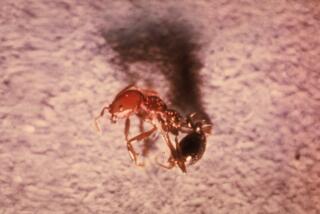Chemically armed mercenary ant armies protect their host
The outsiders arrive at a stranger’s home with lethal chemical weapons, eat the host’s food, kill its children and mutilate the adult females. And yet the host, the Costa Rican ant Sericomyrmex amabilis, is pretty simpatico with the arrangement: It goes along, gets along and survives over the long haul.
There has to be something in the deal for the rather wimpy fungus-rearing host ant, which doesn’t have much of a venom and often quits the battlefield by playing dead.
Evolutionary biologist Rachelle M.M. Adams of the University of Copenhagen believes she knows what makes this social parasitism mutually beneficial.
The houseguests, Megalomyrmex symmetochus, act as a mercenary army, rising up with powerful jaws and a chemical spray to repel a rapacious raider that otherwise would pillage and usurp the mild-mannered colony, according to a study published Monday in the journal Proceedings of the National Academy of Sciences.
That “conditional mutualism,” which makes both species more fit over the long haul, has an analog in human military history, such as when Medieval cities used large amounts of their resources to host contingents of alien soldiers, as a hedge against marauding armies. The evolutionary logic also parallels that of hereditary chronic diseases such as sickle cell, which gives the carrier protection from malaria but shortens the carrier’s life expectancy.
“These two species are cohabitating for years,” Adams said of the ants. “So the parasite’s fitness or benefit accumulates over many years of reproduction. It benefits the parasite to keep the host alive and healthy, so that it can continue to parasitize them over many years.”
Adams basically staged ant fights. She pitted the lethal raider Gnamptogenys hartmani against varying numbers of S. amabilis and its tolerated parasitic guest, M. symmetochus. The best the amicable host could do against the heartless raider was to nip off an occasional leg or antenna, then play dead.
“The strategy does not seem to make sense, but this is something that has been working for the fungus ants for millions of years,” Adams said. “I can’t explain that.”
But M. symmetochus brought death and mayhem with its powerful jaws and aerosol venom. The spray, in fact, amounted to a fog of war. Raiders appeared confused about each others’ identity, turning against each other, Adams found. She next tested whether scouts for the raiders would prefer to attack colonies without the mercenary guest, based on ants’ chemical signatures. Sure enough, the scouts correctly detected the unprotected colonies and summoned their comrades.
Adams speculates that the three species have been locked in a vicious evolutionary cycle dubbed the “red queen hypothesis,” for the Lewis Carroll character in “Through the Looking Glass” who explains to Alice that in Wonderland, “it takes all the running you can do, to keep in the same place.”
The two parasite species and their target host do a lot of adapting just to stay in the niche they occupy. The parasites want what the meek fungus farmers have: food. One evolves to take over the colony quickly, reproduce and get on with life. The other inflicts lesser damage -- clipping the wings of host females so they can’t fly off and mate, eating some of the host’s brood -- but keeps the colony viable.
When there is little threat from the raiding species, Adams speculated, the host likely evolves defenses against the less-lethal parasite. But that makes it susceptible to raids, and the decimation that ensues creates evolutionary pressure to develop a new defense.
Why the host ants did not develop a native defense against the raider is something of a mystery, said Adams, who has been studying the origins and function of social parasitism for a decade. It could just be more efficient to outsource defense, she suggested.
“You could see it as a co-evolutionary arms race,” Adams said. “They could evolve fiercer mandibles that would help them fight against the raiders, or, maybe in this case, they’ve evolved the tolerance for this social parasite that then protects them. It does the same thing. It helps them evade the raider species.”
That could explain why Adams found so many S. amabilis colonies with parasites -– a situation that normally should occur in fewer than 14% of colonies.
“Normally, I go to the field and I look and I look; I go through many host colonies before I find a parasite,” Adams said. “But in this species I just kept finding them. And I just was astounded by how many colonies were parasitized.”
For Costa Rica’s S. amabilis, it seems, the grudging “mi casa es su casa” strategy makes for a crowded but safer house.







